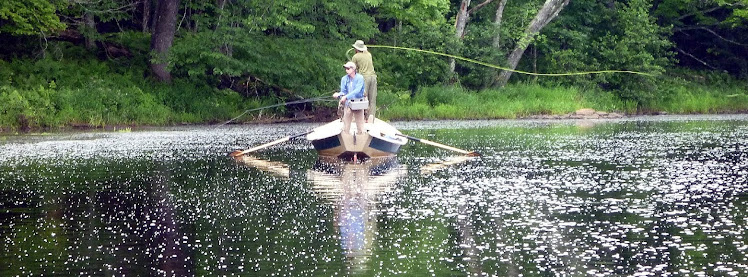Last weekend’s Hawkeye Fly Fishing Association’s Annual Fly Fishing Meeting, i.e. an expo with a meeting, was a great success. It was held in Iowa City, IA. The speakers, including Brian O'Keefe, were well-received. The guest fly tiers were impressive tiers and educators. I spent time with Scott Nordby, http://www.flychucker.blogspot.com/, and Pike fly tier James Durbin, http://www.cowboyflyfishing.blogspot.com/, leaving with a foam beatle and a Pike fly. Of course, I came away with more fly tying supplies and… 2 skunk tails!!! I now have 3 tails but my new ones don’t smell like the one which is still sitting in my garage. I no longer have to debate if I should dare to take that scented tail into my home.
On that note, expect to see blog entries in the near future for a couple fly tying recipes using skunk tail. I spent at least 30 minutes sitting on the floor in the vendor’s room examining tail. It can be soft, supple or coarse, it is frequently luminescent, the white can be white or ‘pee-colored’ and single strands are a solid color or alternate between white and black.
I’m gearing up for the annual Great Waters Fly Fishing Expo, which will be held in Blaine, MN, March 23-25th. The main focus will be helping out at my friends’ booth, promoting fly fishing and Arrowhead Fly Angler guide service, http://www.arrowheadflyangler.com/, serving northern MN and WI). Jackfish Kate will also attend and may help at the booth. For more information about the show, visit this link and look for a discount coupon, too: http://www.greatwatersflyfishingexpo.com/.
The local chapter of HFFA is also in the planning stages of hosting next year’s ‘Annual Meeting’- AKA expo- in Bettendorf, IA. Rumor has it that there will be additional speakers about warm water fishing and local fly fishing opportunities, but many still hope for a fair amount of discourse about Trout in the Driftless Areas of IA, MN, and WI, or in other areas of the country. Attend meetings 1st/3rd Sundays of the month at Riverdale fire station and share your opinion on this club event.
I’ve added another non-profit organization to the ‘Casting It Forward’ page. It’s called ‘Reel Recovery’ and members/volunteers conduct free fly fishing retreats for men recovering from cancer. This year I plan to add more conservation-minded posts to this page on the blog. I am looking forward to posting first-hand accounts of volunteer conservation & fly fishing efforts while promoting organizations & individuals who work anywhere for clean water, happy fish, and happy/healthy anglers. Help me to fill this page!
In the near and distant future (this year), I hope to post informational articles about Smallie and Steelhead fishing after conducting interviews and doing my own research. And, I just thought to myself: why not a Carp story? I’d love a reason to again contact Barry Reynolds; a gentleman very willing to share his time and knowledge of fly angling. **The post to drive me crazy: adhesives. Everything from head cement to UV-cured adhesives will be covered (gulp!) with recommendations for their usage and the creation of a chart (double gulp!!) to provide a quick visual on properties (such as drying time) and their general uses. **I am looking forward to speaking with reps from the IA DNR. Expect a post about the Trout stocking program, including lesser-known information about stocked Trout and their wild counterparts, some added insight to the new trout map, and about the Driftess Area streams. **I'm still searching for fishy recipes. Send me an original! Of course, discourse on the magnificent Musky & additions to the WI-MN Diaries will continue. My goal this year is to self-edit. Entertainment stories must be under 800-1000 words.
 **I do plan on posting more fly tying recipes. I'm currently working on the prototype of the ‘Double Buck’. It is my spin-off of a fabulous large-profile articulated fly I saw last year when fishing with friends from Musky Country Outfitters, http://www.muskycountryoutfitters.com/. And yes, I saw that fly meet with a Musky! Sadly it wasn’t when I fished the fly. I’ve added a collar on my fly to push water. I also plan to make a couple more changes to truly call this challenging tie 'my own'. I may post more info on the success or demise of the fly, but no recipe will be posted until (if) the fly is successfully fished. **I will soon post the PeaBody Nymph. And, can anyone say ‘Bass Flies’? I’ve got a real itch to get into some Smallies this year and who doesn’t like a good Bass tie recipe?!
**I do plan on posting more fly tying recipes. I'm currently working on the prototype of the ‘Double Buck’. It is my spin-off of a fabulous large-profile articulated fly I saw last year when fishing with friends from Musky Country Outfitters, http://www.muskycountryoutfitters.com/. And yes, I saw that fly meet with a Musky! Sadly it wasn’t when I fished the fly. I’ve added a collar on my fly to push water. I also plan to make a couple more changes to truly call this challenging tie 'my own'. I may post more info on the success or demise of the fly, but no recipe will be posted until (if) the fly is successfully fished. **I will soon post the PeaBody Nymph. And, can anyone say ‘Bass Flies’? I’ve got a real itch to get into some Smallies this year and who doesn’t like a good Bass tie recipe?! So, as usual, I have grand plans for posts. IF I win the ‘Mega Millions’ next week, I will post fairly frequently after my month-long fly fishing vacation. If I am required to continue working full-time, I will travel and interview folks, and fish & tie flies when I can. Articles will be posted over the course of the year. Wish me luck!
